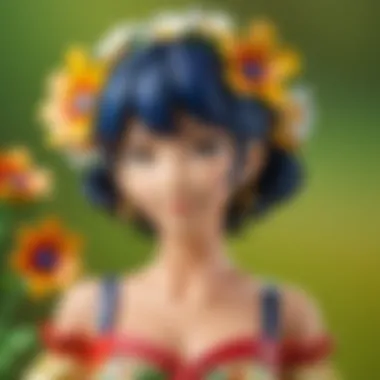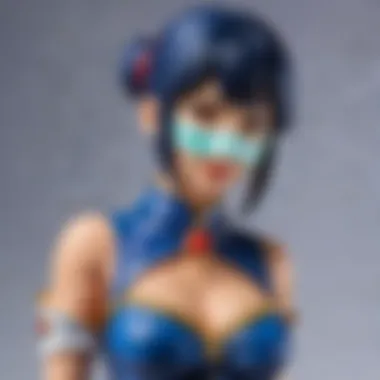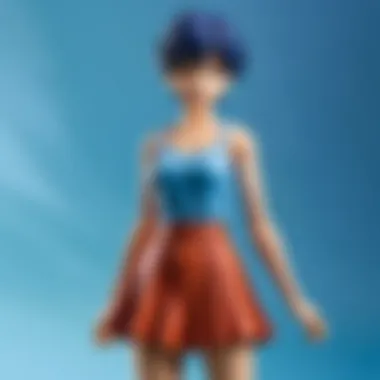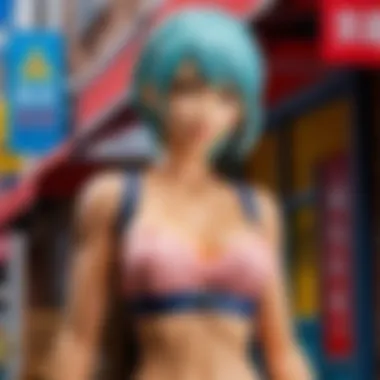Unlocking the Mastery of Figure Photography: A Comprehensive Guide


Featured Figures and Merchandise
Discover the latest Japanese plastic figures and anime merchandise making waves in the market. Embrace the allure of new releases, ranging from intricately detailed characters to vibrant accessories that add depth to every collection. Delve into the world of limited editions, where exclusivity and rarity merge to create a sense of unparalleled value for avid collectors seeking unique treasures. Explore must-have items that set the trend, showcasing popular figures and merchandise that define the pulse of the industry.
Figure Reviews and Analysis
Unveil detailed reviews offering intricate evaluations of specific figures and merchandise. Dive deep into the intricate details, quality, and aesthetics of each product, dissecting every aspect to provide a comprehensive overview for enthusiasts seeking excellence in their collections. Engage in comparative analysis, contrasting features, craftsmanship, and overall value across different products to aid collectors in making informed choices. Delve into the technical specifications and materials used in these figures, unraveling the engineering marvels that bring these characters to life.
Anime Merchandise Trends
Embark on a journey through the ever-evolving landscape of Japanese plastic figures and anime merchandise. Gain profound insights into industry trends, exploring the dynamic shifts and innovations that shape the collectibles market. Step into the collector's corner, where profiles and interviews with passionate collectors showcase the dedication and artistry behind their unique collections. Peer into the future with merchandise forecast, predicting upcoming trends and innovations that will revolutionize the way enthusiasts engage with their favorite figures.
Collector's Tips and Guides
Navigate through essential tips for displaying and maintaining figure collections with finesse. Discover expert advice on showcasing figures effectively, highlighting key elements that enhance the visual appeal of any collection. Unravel the art of purchasing authentic and high-quality merchandise with insightful buying guides tailored to assist enthusiasts in making informed decisions. Engage in the world of DIY customizations, where tutorials and guides offer creative solutions for personalizing and elevating figures to reflect individual tastes and preferences.
Introduction to Figure Photography
Figure photography stands at the intersection of art and precision. It is a creative medium that allows enthusiasts to capture the intricate beauty and essence of Japanese plastic figures with an expert eye. In this comprehensive guide tailored for Collectors, Anime Fans, and Pop Culture Enthusiasts, we will delve deep into the nuanced world of figure photography. From mastering lighting techniques to exploring dynamic compositions, this section serves as a gateway to unlocking the artistic potential within each shot.
Importance of Figure Photography
Highlighting Detailed Features
When it comes to Highlighting Detailed Features, precision is key. This aspect of figure photography enables photographers to showcase the intricate details and craftsmanship of each figure. By emphasizing the minutiae, photographers can elevate the visual appeal and authenticity of their compositions. The meticulous attention to detail in Highlighting Detailed Features adds a layer of depth and realism to the images, captivating viewers and bringing the figures to life.
Expressing Artistic Vision
Expressing Artistic Vision in figure photography is about more than just capturing a figure—it's about conveying emotions and storytelling through visuals. By infusing personal style and creativity into each shot, photographers can elevate their work from mere images to evocative art pieces. The ability to express a unique perspective through Expressing Artistic Vision enables photographers to engage viewers on a deeper level, eliciting emotions and sparking imagination.
Creating Immersive Visual Narratives
Creating Immersive Visual Narratives is the essence of figure photography. It allows photographers to go beyond individual shots and craft cohesive visual stories that resonate with the audience. By setting scenes, using props, and manipulating lighting, photographers can transport viewers into captivating worlds where figures become characters in a larger narrative. The immersive experience achieved through Creating Immersive Visual Narratives adds layers of engagement and intrigue, making each photograph a window into a larger, immersive universe.
Evolution of Figure Photography
From Traditional to Modern Approaches
The evolution of figure photography spans from traditional techniques to modern innovations. From Traditional to Modern Approaches explores how photography styles have adapted to changing technologies and trends. By embracing digital tools and post-processing techniques, modern photographers have expanded the possibilities in figure photography, pushing boundaries and redefining conventions.
Influence of Social Media Trends
Influence of Social Media Trends has revolutionized the way figure photography is shared and consumed. Social media platforms offer a dynamic space for photographers to showcase their work, garner feedback, and connect with a global community. The influence of social media trends has not only shaped the aesthetics of figure photography but also democratized access to this art form, allowing enthusiasts to share their passion with a wider audience.
Impact on Collectors' Community
The Impact on Collectors' Community is profound in the realm of figure photography. Collectors are not just consumers but active participants in this visual art form. The growing community of figure photography enthusiasts has fostered a culture of collaboration, appreciation, and innovation. The impact of figure photography on collectors goes beyond mere documentation; it creates a shared passion that bridges cultures and fosters creative exchange.


Role of Figure Photography in Pop Culture
Promoting Collectibles and Merchandise
Promoting Collectibles and Merchandise through figure photography is an art in itself. By capturing figures in dynamic poses and unique settings, photographers can highlight the value and appeal of collectibles. The artful promotion of collectibles and merchandise not only drives sales but also celebrates the craftsmanship and artistry behind each piece, enriching the collector experience.
Engaging Fans and Followers
Engaging Fans and Followers through figure photography is a powerful tool for building community and connection. By sharing behind-the-scenes insights, creative processes, and exclusive content, photographers can cultivate a loyal fan base that is engaged and inspired. Engaging fans and followers goes beyond likes and comments; it creates a meaningful dialogue between creators and enthusiasts, fostering lasting relationships.
Enhancing Brand Visibility
Enhancing Brand Visibility through figure photography is a strategic way for brands to connect with their audience authentically. By incorporating figures into branding efforts, companies can embody their values, tell their story, and resonate with consumers on a visual and emotional level. The enhanced brand visibility achieved through figure photography creates a lasting impression and sets brands apart in a competitive market.
Essential Gear and Setup
Figure photography, unlike conventional photography, requires particular attention to gear and setup. The selection of essential equipment directly impacts the quality and effectiveness of the final images. The gear needed for figure photography goes beyond just the camera and includes various accessories critical for achieving desired results. The setup, encompassing elements like lighting, backdrop, and props, plays a pivotal role in crafting visually compelling compositions. Attention to detail in gear selection and setup is paramount to elevate the photography experience and output.
Camera Equipment for Figure Photography
Choosing the Right Camera Body
Selecting the appropriate camera body is crucial in figure photography. The camera body determines factors such as image resolution, dynamic range, and low-light performance, all of which directly influence the final outcome. Opting for a camera with a high-resolution sensor and good low-light capabilities ensures detailed and vibrant images, essential for highlighting the intricate features of the figures. The choice of a lightweight and versatile camera body adds to the photographer's mobility and adaptability during shoots. However, balancing features with portability is key to meeting the specific demands of figure photography.
Lens Selection for Different Shots
The selection of lenses is a critical aspect of figure photography. Different lenses offer varying perspectives and focal lengths, influencing composition and visual storytelling. Wide-angle lenses capture expansive scenes, ideal for contextual storytelling, while macro lenses excel in capturing intricate details and textures of the figures. Understanding the characteristics of each lens type allows photographers to create diverse shots that cater to different artistic intents. However, lens selection should align with the photographer's style and the desired mood of the images.
Tripods and Stability Accessories
Stability is essential in figure photography to ensure sharp and clear images. Tripods provide a steady base for the camera, reducing the risk of blur caused by shaky hands or movements. Investing in a high-quality tripod enhances precision and stability during shoots, especially in low-light conditions or when using slower shutter speeds. Stability accessories like ball heads and quick-release plates further improve the flexibility and ease of use of tripods. However, the weight and portability of tripods should also be considered to match the shooting environment and requirements.
Lighting Techniques
Natural Light vs. Artificial Light
Lighting is a fundamental aspect of photography, significantly affecting the mood and atmosphere of the images. Natural light provides a soft and authentic feel to the figures, ideal for showcasing details and textures. In contrast, artificial light offers controllability and consistency, allowing photographers to sculpt light and shadows for dramatic effects. Understanding the characteristics of natural and artificial light sources enables photographers to make informed decisions based on the desired outcome and visual narrative. However, mastering the balance between these light sources is essential in creating captivating figure compositions.
Light Modifiers and Softboxes
Light modifiers and softboxes play a crucial role in shaping and diffusing light, contributing to the overall aesthetic of figure photography. Softboxes create soft, even lighting that minimizes harsh shadows and highlights, ideal for capturing delicate features and textures of the figures. Light modifiers like reflectors and diffusers further enhance the quality of light, adding depth and dimension to the images. Experimenting with different light modifiers allows photographers to control and manipulate light sources creatively. However, understanding the influence of light modifiers on the subject is vital for achieving desired lighting effects.
Creating Dramatic Shadows
Shadows are integral components of figure photography, adding depth, mood, and visual interest to the images. Creating dramatic shadows involves strategic positioning of light sources to cast defined shadows that interact with the figures. By mastering the interplay of light and shadow, photographers can evoke emotion and highlight specific elements of the figures. Manipulating light angles, intensity, and direction contributes to the creation of compelling visuals with dynamic shadow patterns. However, maintaining a balance between light and shadow is key to avoiding overexposure or underexposure in the final images.
Setting the Scene


Backdrop Selection and Material
The choice of backdrop significantly impacts the overall look and feel of figure photography compositions. Backdrops can range from simple monochromatic backgrounds to elaborate themed settings, each enhancing the narrative and aesthetic appeal of the images. Selecting the right backdrop material, whether fabric, paper, or custom designs, complements the figures and adds context to the scenes. The backdrop colors and textures should harmonize with the figures, preventing distractions and directing focus on the main subjects. However, versatility and ease of setup are crucial considerations when choosing backdrops for different shooting scenarios.
Props and Accessories for Composition
Props and accessories play a vital role in enhancing the storytelling aspect of figure photography. From miniature furniture to decorative items, props add visual interest and context to the scenes, creating immersive narratives. Careful selection and placement of props contribute to the overall theme and mood of the images, enhancing their storytelling potential. The scale, style, and relevance of props should align with the figures and the desired narrative, ensuring a cohesive and engaging visual story. However, avoiding clutter and maintaining balance between figures and props is essential for creating harmonious compositions.
Creating a Theme or Storyline
Establishing a theme or storyline elevates figure photography from mere documentation to visual storytelling. Themes provide a conceptual framework for compositions, guiding the choice of figures, props, and settings. A coherent storyline adds depth and emotion to the images, engaging viewers and immersing them in the narrative. Developing a theme requires creativity and attention to detail, aligning elements to convey a unified message or evoke specific emotions. However, balancing realism with artistic interpretation is essential in maintaining authenticity and resonating with the audience.
I anticipate that through this detailed exploration of essential gear, camera equipment, lighting techniques, and setting considerations, readers will gain valuable insights and actionable tips to enhance their figure photography skills. Each element highlighted in this guide serves as a foundation for creating compelling and visually stunning figure compositions, emphasizing the artistry and craft of figure photography.
Mastering Composition and Framing
Mastering Composition and Framing is a fundamental aspect of figure photography that dictates the overall aesthetic quality of the images captured. In this article, we delve into the intricacies of achieving balanced and visually appealing compositions that enhance the storytelling and impact of each photograph. By understanding the principles of composition and framing, photographers can elevate their work from simple snapshots to captivating visual narratives. Within the realm of figure photography, mastering composition and framing allows for the exploration of different perspectives and artistic styles, leading to more engaging and artful representations of the subject.
Rule of Thirds and Leading Lines
Balancing Elements in the Frame
Balancing Elements in the Frame is a critical aspect of the Rule of Thirds and Leading Lines in figure photography. It involves arranging the key elements of the composition in a way that creates visual harmony and interest. By adhering to the rule of thirds, where the frame is divided into nine equal parts, photographers can achieve a more dynamic and visually appealing image. Balancing elements effectively creates a sense of equilibrium and draws the viewer's eye to important focal points within the photograph. Though it may seem simple, mastering the art of balancing elements in the frame can significantly enhance the overall impact of the photograph by creating a cohesive and engaging visual experience.
Creating Visual Interest
Creating Visual Interest plays a crucial role in captivating the audience and conveying the intended message of figure photography. By incorporating elements that add depth, texture, or contrast to the image, photographers can create a sense of intrigue and dynamics that keep viewers engaged. Whether through the use of color, lighting, or unique perspectives, visual interest enhances the overall appeal of the photograph and contributes to its storytelling potential. By mastering the skill of creating visual interest, photographers can elevate their work to evoke emotions, provoke thought, and leave a lasting impression on the audience.
Guiding the Viewer's Eye
Guiding the Viewer's Eye is an essential technique in figure photography that directs the viewer's attention to specific areas of the image. By strategically utilizing leading lines, shapes, or patterns, photographers can control the flow of visual information and lead the viewer through the photograph in a deliberate manner. This not only enhances the narrative structure of the image but also reinforces the intended focal points, adding clarity and impact to the overall composition. Mastering the art of guiding the viewer's eye empowers photographers to communicate their message effectively, ensuring that every element within the frame serves a purpose and contributes to the cohesiveness of the visual story.
Post-Processing and Editing Tips
Post-processing and editing play a crucial role in the realm of figure photography. In the context of this comprehensive guide, these tips serve as the final touch to enhance the visual appeal and storytelling of the images captured. By focusing on specific elements such as color correction, detail enhancement, and overall image refinement, post-processing ensures that the true essence of the figures is portrayed accurately. It allows photographers to fine-tune their creations, bringing out the nuances and intricacies that may not have been initially captured. Furthermore, editing tips aid in maintaining a cohesive look across a series of images, presenting a professional and polished portfolio that resonates with viewers.
Software for Image Enhancement
Adobe Photoshop Techniques
Adobe Photoshop stands as a cornerstone in the world of image editing. Its versatility and extensive toolset make it an indispensable choice for photographers seeking precision and control over their post-processing workflow. Through Adobe Photoshop Techniques, photographers can delve into advanced editing functions such as layer adjustments, masking, and retouching, enabling them to elevate their images to new heights. The unique feature of non-destructive editing allows for experimentation without compromising the original image quality. However, the intricate interface and steep learning curve may pose challenges for beginners seeking to harness the full potential of this software.
Lightroom for Color Correction
Lightroom's specialized focus on color correction and RAW image processing makes it an essential tool for photographers aiming for consistent and vibrant visuals. The intuitive interface and dedicated modules for color adjustments streamline the editing process, ensuring that images maintain a cohesive look and feel. Lightroom's non-destructive editing preserves the original image data, allowing for seamless corrections without compromising quality. Despite its efficiency in color correction, Lightroom may lack the advanced editing features found in software like Photoshop, limiting its capabilities for complex retouching tasks.
Adding Special Effects


The inclusion of special effects in post-processing opens up a realm of creative possibilities for figure photography. From adding surreal textures to applying unique filters and overlays, special effects can transform a mundane image into a visually captivating masterpiece. By experimenting with lighting effects, blending modes, and creative filters, photographers can infuse their images with an extra layer of emotion and style. However, the key lies in striking a balance between enhancing the narrative of the photograph and avoiding over-processing that may detract from the figure's intrinsic charm.
Maintaining Authenticity in Editing
In the digital age of photography, maintaining authenticity in editing is paramount to preserving the integrity and originality of the captured moments. Through techniques such as retouching without losing originality, photographers can enhance their images while retaining the true essence of the figures. This approach involves subtle adjustments that refine the visual appeal without altering the fundamental characteristics of the subject. By focusing on preserving details and colors, photographers can ensure that the essence of the figures remains true to life, capturing the intricacies and nuances that define them.
Retouching Without Losing Originality
Retouching without losing originality allows photographers to address minor imperfections and distractions in an image while preserving the authenticity of the scene. By utilizing subtle retouching tools and techniques, photographers can enhance the overall aesthetic appeal without compromising the integrity of the figures. This delicate balance ensures that the final image reflects the essence of the subject while presenting a polished and refined look. However, the challenge lies in maintaining a natural appearance throughout the editing process, avoiding overly edited or artificial outcomes.
Preserving Details and Colors
Preserving details and colors is essential in figure photography to capture the realism and vibrancy of the figures. Through meticulous color correction and detail enhancement, photographers can bring out the intricate textures and nuances present in the figures. This approach involves fine-tuning the color balance, saturation levels, and contrast to ensure that the images accurately represent the visual characteristics of the subjects. By preserving the details and colors, photographers can evoke a sense of realism and authenticity in their images, making the figures come to life in a dynamic and engaging manner.
Balancing Realism and Artistic Flair
Balancing realism and artistic flair in editing is a delicate art that requires keen attention to detail and creative vision. By striking a harmonious equilibrium between realistic representation and artistic expression, photographers can create visually captivating images that resonate with viewers. This balance involves judiciously applying editing techniques to enhance the aesthetic appeal while maintaining the authenticity of the figures. Through careful consideration of color grading, effects application, and tonal adjustments, photographers can infuse their images with a unique artistic flair that sets them apart while ensuring that the original essence of the figures remains unaltered.
Exporting and Sharing the Final Image
Once the post-processing and editing phases are complete, the final step in the figure photography journey involves exporting and sharing the finished images. Optimizing image formats for web distribution is crucial to ensure that the visuals are displayed online in the best possible quality. By selecting the appropriate image compression settings and file formats, photographers can strike a balance between image quality and loading speed, optimizing the viewing experience for online audiences. Additionally, developing effective social media sharing strategies allows photographers to showcase their work to a wider audience, engaging with fellow enthusiasts and expanding their reach within the community. Building an online portfolio serves as a digital showcase of the photographer's talent and body of work, providing a centralized platform for viewers to explore and appreciate the captivating world of figure photography.
Conclusion and Future Trends
Figure photography represents a captivating blend of art, technology, and creativity, and as with any evolving art form, reflecting on its journey is imperative. Understanding the nuances of figure photography is essential for enthusiasts and professionals alike. Exploring the varied aspects, from the technicalities of lighting and composition to the emotional depth captured in the frames, allows for a holistic view.
Considering future trends in figure photography opens doors to innovation and adaptation. Embracing technology, such as augmented reality integration, can usher in a new era of interactive experiences for viewers. Collaborations with digital artists bring fresh perspectives and enhance the storytelling capabilities of figure photography. Anticipating these trends enables practitioners to stay ahead of the curve and explore novel ways of showcasing their art.
Reflecting on Figure Photography Journey
Personal Growth and Artistic Development
Reflecting on the personal growth and artistic development fostered by figure photography unveils the transformative power of this art form. It allows individuals to hone their creative skills, developing a unique visual language that resonates with audiences. The meticulous attention to detail required in figure photography nurtures patience and precision, qualities essential for mastering this craft. This journey towards artistic excellence not only shapes one's photographic style but also instills a sense of accomplishment and fulfillment, driving continuous improvement.
Challenges and Rewards of the Craft
Delving into the challenges and rewards of figure photography illuminates the dedication and resilience demanded by this pursuit. Overcoming technical hurdles and achieving desired outcomes entail perseverance and a keen eye for detail. However, the rewards are equally fulfilling, playing a significant role in boosting confidence and honing one's artistic vision. The satisfaction derived from creating evocative compositions and evoking emotions through photography is unparalleled, making the challenges a worthwhile endeavor.
Inspiring Others in the Community
Inspiring others in the figure photography community creates a ripple effect of creativity and collaboration. Sharing experiences, techniques, and insights fosters a supportive environment where budding photographers can flourish. By promoting a culture of mentorship and knowledge exchange, seasoned practitioners uplift the community as a whole, nurturing talent and sparking innovation. Inspiring others not only fuels personal growth but also contributes to the collective evolution of figure photography, ensuring its vitality and relevance.
Anticipated Trends in Figure Photography
Augmented Reality Integration
Exploring augmented reality integration in figure photography holds the promise of transcending traditional boundaries by immersing viewers in interactive, multifaceted storytelling experiences. By blending the real and virtual worlds seamlessly, augmented reality enhances engagement and cultivates sensory-rich narratives. This innovative approach not only enriches the viewer's experience but also opens avenues for novel presentation styles and narrative techniques.
Interactive Display Technologies
The advent of interactive display technologies revolutionizes the presentation and consumption of figure photography. Interactive displays enable users to engage with the artwork actively, fostering a sense of participation and co-creation. By leveraging touchscreens, sensors, and interactive elements, photographers can deliver dynamic visual experiences that captivate and intrigue viewers. This technology-driven evolution in presentation elevates figure photography to new heights of interactivity and engagement.
Collaborations with Digital Artists
Collaborating with digital artists introduces a fusion of analog and digital creativity, expanding the artistic horizons of figure photography. By combining traditional photography techniques with digital artistry, practitioners can amplify the visual impact of their work and experiment with avant-garde aesthetics. Collaborations with digital artists enable cross-pollination of ideas, pushing the boundaries of conventional photography and fostering a culture of experimentation and innovation. This symbiotic relationship paves the way for groundbreaking artistic collaborations and eclectic visual expressions.



